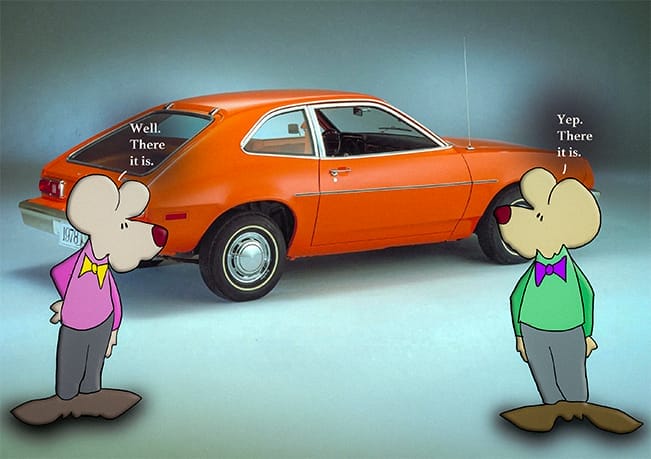I’m a little embarrassed to say it, but when I was in high school, we used to joke around about the Ford Pinto. It was all because of the fateful crash in 1978, where three teenage girls died after their 1973 Ford Pinto was rammed from behind by a van. It then burst into flames, and they were all killed. And not so far from home. It happened on an Indiana highway. This fatal crash, along with other Pinto accidents, caused a national scandal around the Pinto during the 1970s.
So, if someone in our school drove a Ford Pinto, we would kid them, saying, “Your parents must not love you very much.” And then the ribbing would continue along those lines. We’d all get a big laugh out of it. Stupid me. Stupid kids. Because the truth behind the car was tragic.
The back story of the Pinto isn’t too terribly long. It debuted in 1970, and it was Ford’s first subcompact car produced domestically. Small and economical. The Pinto was Ford’s answer to popular imports like the Volkswagen Beetle and the Toyota Corolla.
So, Lee Iacocca was an executive vice president at Ford at the time. Most of us remember him as the head of Chrysler. Anyway. He was the one who spearheaded the Pinto’s development. And, as things went, the initial reviews of the Pinto were largely positive. They sold a lot of them.
But just a few years later, by 1974, rumors began to surface. In-house and out-of-house. The “buzz” was that the Pinto had a tendency to catch fire in rear-end collisions.
In May 1972, a California woman was killed when her Pinto caught fire after being rear-ended on a highway. Her passenger, Richard Grimshaw, was burned over 90 percent of his body but survived. He sued Ford for damages. During that case, Grimshaw’s lawyer found that the Pinto’s gas tank sat behind the rear axle. In that location, it was particularly vulnerable to damage by rear-end collisions. He also uncovered evidence that Ford had known about this weakness ever since the Pinto first went on sale.
Ford knew about it and chose to do nothing about it. Their reasons, they said, were mostly because changing the design would have been too costly.
Above and beyond all of that, an article in Mother Jones magazine in the fall of 1977 exposed the Pinto safety concerns. Now, the nation knew too. But, back in California, that jury awarded $128 million to Grimshaw in February 1978. And this settlement spread the news still further.
That June, Ford voluntarily recalled all 1.9 million 1971-1976 Pintos and 1975-1976 Mercury Bobcats (which had the same fuel-tank design).
Tragically, the girls who died in the rear-end collision in Indiana on August 8, 1978, were apparently unaware of the Pinto-related dangers.
Tragically, again, their family would not receive a recall notice until early 1979.
But here is the big thing. Accountability vs. Big Dollars
A grand jury would later return indictments against Ford on three counts of reckless homicide in the case. This decision by the court marked the first time in history that a corporation had been charged with murder.
Ford claimed that Pinto’s fuel-tank design was the same as other subcompacts and that the company had done everything possible to comply with the recall once it had been enacted.
Due to a lack of evidence, the jury found Ford not guilty in that case.
Make of this what you will. But my guess is, if “Joe Average Mechanic” had built that car and sold it to those girls, knowing there was a terrible danger, Joe would have found his butt behind bars for life. Or worse. But it was not an average Joe. It was Ford Motor Company, who had lots of money to put in the right places, and the right pockets, to keep themselves from being convicted.
“””””””””
“With great power comes great responsibility.” – Voltaire
“””””””””
“The tragedy of life is in what dies inside a man while he lives.” – Albert Schweitzer
“””””””””
“The trust of the innocent is the liar’s most useful tool.” – Stephen King
“””””””””
The bad car. It was no joke.
